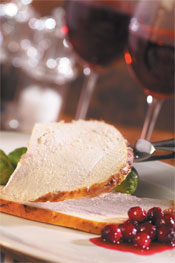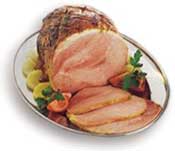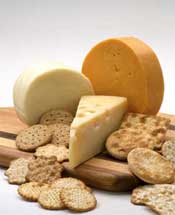CHRISTMAS FEAST - Christmas Turkey / Christmas Ham / Mollet Bantam Eggs on Crabmeat & Celeriac Julienne / Clementines in Cinnamo
The biggest meal of the year can be quite a challenge, especially if it’s the first time your turn has come around to cook for a large family and maybe other guests too. Many families wouldn’t hear of anything but the traditional turkey and ham, in which case give in gracefully and be grateful that you have been spared the agony of choice - and it is in any case the ideal solution when a lot of servings are required.
When numbers are manageable (8 or less), the options are much wider - goose is a real treat, but remember they are heavy-boned birds so you’ll only get about eight servings from an average goose; duckling is a practical option to serve four, and can be scaled up easily; game birds, especially pheasant which has a good proportion of meat on it, makes a good choice for 2-3 people, and also scales up easily –or you could try roast venison, from the beautifully photographed culinary journey around Ireland, “Irish Country House Cooking” (Epicure Press, EUR25), and vegetarians will find ideas a-plenty for both the main course and accompaniments in Denis Cotter’s “A Paradiso Year/Autumn and Winter Cooking” (Atrium Press, EUR19.95)
NIBBLES & STARTERS
Nibbles with drinks are needed over a long period in most households as people come and go on Christmas Day, so it may be best to skip starters and go straight into the main course or stick to the simplest of foods like natural oysters or smoked salmon. Fashionable nibbles that you might like to offer include sushi, mini-kebabs, mini meatballs with dips, tempura prawns and so on (for ideas, see the chapter on Finger Food in Darina Allen’s new book, ‘Easy Entertaining’, Kyle Cathie stg£25, which also includes food and wine pairings by Tom Doorley), but simplest is often best on this busiest of days and favourite festive bites like spiced beef and/or smoked salmon (preferably wild) on brown bread, and duck or goose liver pate are all much easier to prepare and invariably welcome.
If you do decide to offer a ‘proper’ starter, choose something cold like Salmon Carpaccio (from Belle Isle Cookery School – in ‘Irish Country House Cooking’, as above) which can be prepared ahead, or a refreshing salad such as Mollet Bantam Eggs on Crabmeat & Celeriac Julienne, a beautiful, utterly simple and very French dish from the delectable new book ‘Eggs’ (hardback stg£14.99) by Michel Roux, of the renowned Waterside Inn at Bray in Berkshire. Michel says ‘you can use frozen or canned crabmeat for this starter, but fresh crabmeat has a superior flavour’; I suggest using vacuum-packed fresh crabmeat (Nolans), which is available from supermarkets such as Superquinn.
Mollet Bantam Eggs on Crabmeat & Celeriac Julienne
Mollet eggs are like soft-boiled eggs, and ordinary hen’s eggs can replace the bantam eggs: cook for just 3 minutes after the water (started from cold) starts simmering; bantam eggs need only 11/2 minutes.
Although it may seem contrary to suggest it, the eggs might be omitted for Christmas Day, making a simple crab & celeriac salad, and Michel’s special swiss vinaigrette could be replaced with a dressing of your choice. Serves 4:
1 celeriac, about 450g
Swiss vinaigrette (recipe given in the book)
250g fresh white crabmeat
Juice of 1/2 lemon
salt & freshly ground pepper
4 bantam eggs, or hen eggs (optional)
1 tender lettuce heart, about 8 leaves
1/2 lemon, cut into 4 wedges
2 tbsp flat parsley leaves
Peel the celeriac with a sharp knife, discarding all the hard bits, and cut into julienne on a mandolin. Toss with 4 tbsp vinaigrette and keep at room temperature.
Check the crabmeat carefully, removing any cartilage and fragments of shell. Mix with the lemon juice and season with pepper and salt to taste.
Cook the mollet eggs, then peel them under cold running water.
Divide the celeriac between 4 plates. Pile a crabmeat dome in the centre and top with the bantam eggs. Arrange a couple of lettuce leaves, a lemon wedge and some parsley on one side. Drizzle a little vinaigrette over the eggs and serve the rest separately. Serve chilled.
CHRISTMAS TURKEY
 Fresh is best (and free range best of all) and this recipe, based on a medium-sized turkey, is ideal for most families. The stuffing method - under the skin rather than inside the bird - keeps the breast moist, is easier to serve and is safer because it allows heat to penetrate more evenly.
Fresh is best (and free range best of all) and this recipe, based on a medium-sized turkey, is ideal for most families. The stuffing method - under the skin rather than inside the bird - keeps the breast moist, is easier to serve and is safer because it allows heat to penetrate more evenly.
It comes from Bord Bia's classic Christmas recipe leaflet "Tastes of the Season", which is available free of charge by calling +353 (0)1 668 5155 and the recipes - including seasonal vegetable accompaniments and a new range of easy recipe suggestions for quick meals - are also on the Bord Bia website.
14lb/ 7 kg approx. turkey, oven-ready (with giblets)
Salt, black pepper & a little flour
2 tbsp softened butter
8-10 slices streaky bacon
Thyme & Onion Stuffing:
1 lb/450g day old bread (without crusts), cubed
6 tbsp fresh parsley, chopped
2 tbsp fresh thyme, chopped
1 medium onion, peeled & quartered
Salt & black pepper
4-6 oz/100-150g butter, softened.
First make the stuffing: put the bread, parsley, thyme and onion into a food processor and chop finely without over-processing. Turn into a bowl, season and mix in the butter.
To stuff the turkey: loosen the skin at the neck end with your hand and stuff between the skin and the flesh, allowing space for it to expand during cooking. Tuck the neck flap under the bird's back and secure with a cocktail stick. Put any remaining stuffing into a buttered baking dish; cover and cook with the turkey.
Weigh the stuffed turkey and calculate the cooking time, allowing 15-20 minutes per lb/450g (allow 10-15 minutes per lb/450g for turkeys weighing over 16 lb/8 Kg). Place the turkey, breast side up, in an oiled roasting tin.
To cook: preheat a hot oven, 450'F/220'C/gas mark 7.
Season the turkey with salt and pepper, dust with a little flour and lay the bacon slices over the breast, overlapping, and cover with a piece of buttered greaseproof paper (to keep the rashers in place). Wrap the turkey loosely in foil, put into the oven and roast for 3/4 of an hour before reducing the heat to 325'F/170'C/gas mark 3. Remove the foil (and add bacon rolls and/or sausages, if using) for the last half hour. To test, pierce the thickest part of the leg - the juices should run clear without any trace of blood.
When cooked, transfer the turkey to a large serving platter, reserving the pan juices for gravy. Cover the turkey loosely with foil and allow to rest for half an hour in a warm place while making the gravy and finishing the ham (if using) and vegetables.
Gravy: to make stock day before, simmer the giblets with onion slices, a bay leaf and enough water to cover generously; strain and season.
Pour off excess fat from the roasting tin and, into the remaining fat and juices, stir about a tablespoon of flour (or as much as the fat and juices will absorb). Cook over moderate heat, pour in the stock and blend well with a whisk to prevent lumps. Add a dash of wine and simmer for 2 or 3 minutes, stirring. A tablespoon of redcurrant jelly or a little balsamic vinegar will also add flavour. Season to taste.
Cranberry Sauce can be made several days ahead, keeps well in the fridge and is excellent with lamb, pork and ham as well as all kinds of poultry: check through a packet (12 oz/325g) of fresh cranberries and discard any discoloured berries, then put into a saucepan with 8 oz/225g sugar and 1/4 pint/125ml water; warm through to disoolve the sugar, then simmer everything together for 5-10 minutes. Cool, then chill until required.
CHRISTMAS HAM
 There’s a recipe for Honey Glazed Ham in Bord Bia’s ‘Tastes of the Season’, and ‘Neven Maguire’s Cookery Collection’ (Poolbeg EUR19.99) is another reliable reference - he suggests a sage, apricot and pine nut stuffing for the roast turkey, and gives a recipe for Irish whiskey and maple glazed ham, which is not difficult although it does mean a certain amount of advance planning.
There’s a recipe for Honey Glazed Ham in Bord Bia’s ‘Tastes of the Season’, and ‘Neven Maguire’s Cookery Collection’ (Poolbeg EUR19.99) is another reliable reference - he suggests a sage, apricot and pine nut stuffing for the roast turkey, and gives a recipe for Irish whiskey and maple glazed ham, which is not difficult although it does mean a certain amount of advance planning.
If time is a problem for you, a prepared product like Brady Family Ham (Tel +353 (0)45 863650) could be the answer: this naturally produced ham Quality Assured Irish ham is slow cooked in Co Kildare, to a family recipe - it has excellent flavour and texture and could be the saving of many a hard-pressed cook this Christmas.
A whole traditional ham on the bone requires only an hour or so to reheat before serving and costs EUR50-60 depending on size; it is also available off the bone, and in smaller sizes, eg a half ham on or off the bone, and is available within 2 days of ordering from your local SuperValu and a number of independent retailers nationwide, including Donnybrook Fair in Dublin.
DESSERT
We featured our favourite traditional Christmas Pudding in this column a few weeks ago and, although we enjoy a hot white rum sauce with it, you could simply offer whipped cream and the one of the traditional hard sauces - rum or brandy butter, made with equal amounts of soft butter and sugar whipped up and flavoured to taste with rum or brandy - which melt deliciously into the hot pudding.
Clementines in Cinnamon Caramel
This recipe from Paul Flynn’s new book ‘Second Helpings’ (Collins Press, EUR30) makes a refreshing alternative to a hot pudding, and Paul likes to serve it in a funky glass bowl so people can appreciate the jewel-like clementines immersed in amber nectar. Serve with crème fraîche or yogurt, and some toasted nuts, if you like.
Serves 4
8 clementines
200g/7 oz sugar
2 cinnamon sticks
2 tablespoons orange-flavoured liqueur, eg Cointreau or Grand Marnier
Crème fraîche and chopped toasted pecan or hazelnuts, to serve
Using a vegetable peeler, pare the rind from two of the clementines and cut it into fine strips. Set aside. Peel the clementines, removing all the pith but keeping them intact, then put them into a glass serving bowl. In a heavy-based pan gently heat the sugar with 2 tablespoons of water until the sugar melts, stirring occasionally. Increase the heat a little and allow to bubble without stirring until the mixture turns a rich golden colour, then immediately turn off the heat.
Cover your hand with a tea towel and pour 1/2 pint/300ml of warm water into the caramel - the mixture will bubble and splutter. Return to the heat and bring slowly to the boil, stirring until the caramel has dissolved. Add the reserved shredded rind and cinnamon sticks and simmer for another 5 minutes ntil slightly reduced. Stir in the orange-flavoured liqueur and leave the syrup to cool for about 10 minutes, ten pour overthe clementines and cover the bowl with a flat plate. Chill for several hours or overnight, turning the clementines occasionally so they marinate evenly.
To serve, allow the clementines to come back up to room temperature, then place the bowl straight onto the table and divide among individual serving bowls. Add dollops of crème fraîche and a sprinkling of toasted pecans or hazelnuts.
Ingredient of the week...THE CLASSIC CHEESEBOARD
 What is it?
What is it?
In his excellent newly-published book ‘Real Flavours - the handbook of gourmet & deli ingredients’ (Grubb Street, stg£15.99), TV chef Glynn Christian includes an extensive and highly informative chapter on cheeses, in which he says: “The classic cheeseboard goes for contrast. A savoury blue cheese (Stilton), a full-flavoured pressed cheese (Cheddar) and a creamy soft cheese (Brie) gives an ideal foundation. Within each of those flavour styles there is much opportunity for originality... and there are other styles of cheeseboards, incuding a ‘horizontal collection’ of similar types of cheese, eg three goat cheeses.”
Where can I get it?
For hands-on advice in Ireland, you look no further than the renowned Sheridan’s Cheesemongers (www.sheridanscheesemongers.com), who have stores in Dublin (Pembroke Lane, Dublin 4 and South Ann Street, Dublin 2) and Galway (14-16 Churchyard Street - where there is also a wine bar and wine shop on the first floor) and eight market stalls in Dublin, Kildare and Galway. They recommend a ‘yuletide trio’ of Brie de Meaux, Montgomery Cheddar and some Stilton - or perhaps an Irish version of Cashel Blue; Mount Callan or Desmond and one of the fantastic Irish semi-soft farmhouse cheeses (Gubbeen, Durrus, Ardrahan or Milleens). Hampers consisting of cheeses and a range of artisan products are available - including a Sheridan’s Port and Stilton Hamper (EUR30), and membership of the Sheridan’s Cheesemongers Cheese Club (EUR35 per month) for a gift that lasts all year, with seasonal cheeses, tasting notes and cheese accompaniments delivered to home or office each month.
How do I store it?
Sheridan’s recommend the fruit and vegetable compartment of the fridge for storing cheese, as it is the warmest area. Keep it well wrapped in waxed or greaseproof paper to prevent it from losing its flavour and going hard. Be patient and allow cheese to come naturally to room temperature before serving, as this lets the flavour and aroma develop to its fullest.
How do I serve it?
Keep it simple - Glynn Christian advises “a maximum of...three cheeses for a table of six, or six cheeses for a buffet for 30 - large inviting pieces of cheese, rather than small mean pieces which will quickly crumble and become untidy when cut by your guests”. And finally, a frequently asked question - should we serve port in the Stilton? Absolutely not, says Christian: “Port is an accompaniment to Stilton, not an ingredient. To soak a perfect Stilton in an excellent port dilutes the flavour, texture and nuances of both.”





There are currently no comments
Leave a comment
Not a member? Register for your free membership now!
Or leave a comment by logging in with: